Killer Sudoku (24 page)
Authors: Kaye Morgan

When Will Singleton caught up with Liza, his expression blended relief with disappointment. “You know, you and Conklin were almost in a dead heat for first place throughout the tournament,” he told her. “But when neither of you showed up for the Winner Takes All round—”
“So who did win?” Liza asked.
“Doc Dunphy, as he likes to be called now.” Liza caught a hint of a grin under Will’s facial foliage. “When she interviewed him, Charley Ormond seemed quite taken. I may have created my own worst competition.”
“After his experiences, I think old Doc will be a bit more wary of the whole celebrity thing,” Liza said. “Let the new king enjoy his crown.”
“But you . . .” Will broke off when Liza made a face and waved off his apologies.
“There’s always next year,” she told him.
Ava Barnes called, demanding an exclusive for the
Oregon Daily
. Liza agreed to a twenty-minute interview.
Oregon Daily
. Liza agreed to a twenty-minute interview.
Charley Ormond hoped for a SINN exclusive, too, but Liza let Will do the talking.
A frantic Michael showed up at the police station. He was lucky no cops had caught him on his high-speed progress from Westwood to Newport Beach.
“What about your script?” Liza asked.
“The hell with that,” he answered. “I had to make sure you were all right.”
Once he was assured of that, Michael immediately started in on Kevin for letting Liza get into danger. Kevin was already in a bad mood. The police had discovered the reason for the Porsche’s erratic behavior at high speed. Kevin hadn’t replaced the gas cap correctly after filling up the car, and fuel had been escaping to get onto the rear wheels. Wounded right in his masculinity, Kevin was restrained from hauling off and belting Michael only by some severe words by Mrs. H.
In the end, she sent them both out the door of the suite. Liza had distanced herself from the whole scene by going out onto the balcony. Evening was coming on, and she was enjoying the view of the bay getting darker while the lights of the surrounding town began to sparkle.
“Restful,” Mrs. Halvorsen said as she joined Liza outside.
“Which is more than we can say for the rest of this weekend.” Liza shook her head. “We have to fly back home tomorrow, just when I feel that I could really use some pampering.”
“Maybe you could take some more time off,” Mrs. H. suggested. “Go to the Killamook Inn for a couple of days.”
“Yeah, well . . . the days might not be a problem, but the nights up there with Kevin—not such a good idea.”
Mrs. H. sighed with the disappointment of the dedicated matchmaker. “When you were a little more than a toddler, I managed to get a good deal on a kiddie pool.”
“I remember that!” Liza said. “On hot afternoons I’d come over, you’d fill it with a hose, and I would splash.”
Mrs. Halvorsen nodded with a reminiscent smile. “For the next year, you used to call me Mrs. Pool. You know, I think I still have it somewhere in my garage.”
Liza chuckled. “Great! Maybe we can dig it out. I’ll set it up in my backyard and sit out in it—probably with Rusty in my lap—and try to do sudoku.”
“That’s the spirit!” Mrs. Halvorsen joined in the laughter.
“It might not be too bad, especially the sudoku.” Liza got a bit more serious. “Just one other thing. I’ll need a beach umbrella, big enough to shade the whole pool.”
“Why ever would you need that?” Mrs. H. wanted to know.
“It’s going to be a long time before I’ll feel comfortable with tanning goo,” Liza told her. “A very long time.”
Sudo-cues
Dot’s an Idea
Written by Oregon’s own leading sudoku columnist, Liza K
We’ve talked in the past about sudoku size in terms of the number of initial clues. This time around, I’m concerned with the physical size of the puzzle. Back in the start-up days of this column, working with a single newspaper, I had some animated discussions with the layout people, warning that about three inches square was the smallest they could get away with shrinking a sudoku. And that’s scarcely ideal.
Unlike crossword blanks, which just need to be large enough to take a letter, an empty sudoku square has to act as a workspace, a place to list the possible candidates that could occupy that position in the puzzle. In a perfect universe, such a space should be a half-inch or three-quarters of an inch square, but that would mean four-and-a-half or seven-inch sudoku. In a world where newsprint is expensive and comic strip panels have shrunk to postage-stamp size, newspapers just aren’t going to do that.
Unless the periodical is devoted to sudoku, the most generous allotment of space is about three inches, meaning a blank space takes up a little more than one-third of a square inch. I’ve seen some puzzles reduced to two inches square. How are you supposed to fit all the necessary candidates in there? Using the sharpest pencil, you’re reduced to using a letter size usually reserved for really objectionable clauses in contracts.
I tend to use the margins around the puzzles to list the missing numbers in columns, rows, and subgrids. And like a lot of citizens of Sudoku Nation who aren’t twenty-nine anymore, I’ve used photocopiers to enlarge teeny-tiny sudoku to more manageable working proportions. That works fine if you’re in a home office or a business not patrolled by the Photocopy Police. But suppose you’re riding (not driving!) to work and you’ve got to work with a puzzle as it is?
Even if you manage to fit in the candidates, you’re expected to erase them as they’re eliminated. More likely you’ll erase several that you need trying to get rid of the one you don’t. And given the state of newsprint, you’ll end up with a grayish smear—or at worst, a hole.
Recently, I’ve noticed some people using a simpler method on these miniature puzzles, a positional notation to mark possible candidates.
That’s a very fancy way of saying they use dots instead of numbers. Let’s zoom in on a rare phenomenon, a sudoku blank with a full range of candidates. Listing them would probably look like this:
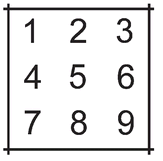
Not easy to do in under a quarter inch of space. But it takes a lot less pencil work (and space) to represent these same positions with dots:
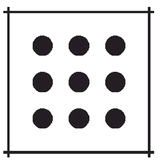
Instead of erasing, you just cross out eliminated candidates, like so:
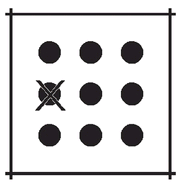
Let’s take the system for a test-drive with a fairly simple puzzle.
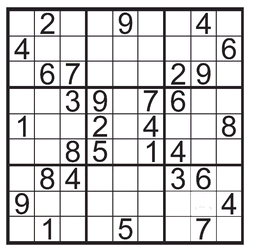
This won’t take you more than halfway down the list of twelve standard sudoku solving techniques. There are no X-wings, no swordfish, no need for the more esoteric forms of logic chains, and if you’re halfway decent at sudoku solving, no need to look in the back of the book.
So, let’s start with the first technique—hidden singles. Looking across the middle tier of subgrids, starting down from Row 4, you can find the number 8 in both the left-hand set of nine spaces and in the right-hand box. The center subgrid has only three open spaces. With the 8s in Row 5 and Row 6 prohibiting two of those spaces, we can place an 8 as shown in Row 4.
That center tier also has two 4s, in the central box and the right-hand box, respectively. Crosshatching with the two 4s in the upper-left-hand and lower-right-hand boxes leaves only one space in the leftmost box in the center tier. We’ve placed a 4 in there, as shown.
The bottom tier of three subgrids also has two boxes with a 4. From their locations, they eliminate six of the eight available blank spaces in the bottom center box. A 4 in the central box in the tier above eliminates another possible space, leaving only one, where we have marked another 4.
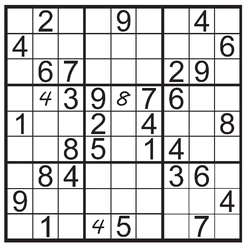
So now we have thirty clues and three solved spaces—forty-eight spaces to go.
At this point in the puzzle there are no naked singles. Usually, you’d try this technique on the more filled-in rows, columns, or boxes. The central box has seven spaces filled, but more than one possibility for the remaining two. Row 4 has three blank spaces, but each of those has more than one possible occupant.
Our usual next step is to start nominating candidates. Here’s what the puzzle would look like if you used the usual method of filling empty spaces with small numbers:
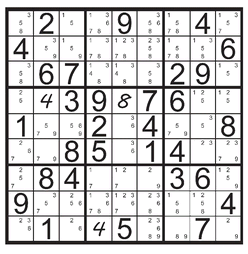
Other books
Lessons In Stalking: Adjusting to Life With Cats by Dena Harris
Birth School Metallica Death - Vol I by Paul Brannigan, Ian Winwood
Tell Me No Lies by Delphine Dryden
One Night with Sole Regret 04 Touch Me by Olivia Cunning
Fire Song by Libby Hathorn
Tango by Alan Judd
The Unseen Tempest (Lords of Arcadia) by John Goode, J.G. Morgan
The Flame Priest (The Silk & Steel Saga) by Karen Azinger
Ambush in the Ashes by William W. Johnstone
Rain Falls by Harley McRide